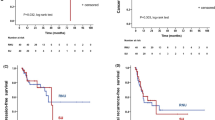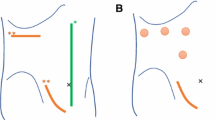Abstract
Purpose
This study investigates the utility of ureteroscopic surgery (URS) as an alternative to radical nephroureterectomy (RNU) in managing upper tract urothelial carcinoma (UTUC), with a focus on survival outcomes and re-evaluation of current the European Association of Urology guidelines criteria.
Methods
We conducted a retrospective, multi-institutional review of 143 UTUC patients treated with URS (n = 35) or RNU (n = 108). Clinicopathological factors were analyzed, and survival outcomes were assessed using Kaplan–Meier analysis and Cox proportional-hazards models.
Results
The median follow-up period was 27 months. Overall survival (OS) and radiographic progression-free survival (rPFS) were comparable between the URS and RNU groups (OS: HR 2.42, 95% CI 0.63–9.28, P = 0.0579; rPFS: HR 1.82, 95% CI 0.60–5.47, P = 0.1641). URS conferred superior renal function preservation. In patients characterized by factors such as radiographically invisible lesions, negative cytology, pTa stage, low-grade tumors, and multiple lesions, the OS outcomes with URS were comparable to those with RNU as follows: radiographically invisible lesions (P = 0.5768), negative cytology (P = 0.7626), pTa stage (P = 0.6694), low-grade tumors (P = 0.9870), and multiple lesions (P = 0.8586).
Conclusion
URS offers survival outcomes similar to RNU, along with better renal function preservation, especially in low-risk UTUC patients. These findings underscore the urgency of re-evaluating the current EAU guidelines and encourage further research into determining the ideal patient selection for URS in UTUC treatment.



Similar content being viewed by others
Data availability
No datasets were generated or analyzed during the current study.
References
Siegel RL, Miller KD, Fuchs HE, Jemal A (2022) Cancer statistics, 2022. CA Cancer J Clin 72:7–33
Roupret M, Seisen T, Birtle AJ, Capoun O, Comperat EM, Dominguez-Escrig JL et al (2023) European Association of Urology Guidelines on upper urinary tract urothelial carcinoma: 2023 update. Eur Urol 84:49–64
Bin X, Roy OP, Ghiraldi E, Manglik N, Liang T, Vira M et al (2012) Impact of tumour location and surgical approach on recurrence-free and cancer-specific survival analysis in patients with ureteric tumours. BJU Int 110:E514–E519
Grasso M, Fishman AI, Cohen J, Alexander B (2012) Ureteroscopic and extirpative treatment of upper urinary tract urothelial carcinoma: a 15-year comprehensive review of 160 consecutive patients. BJU Int 110:1618–1626
Seisen T, Peyronnet B, Dominguez-Escrig JL, Bruins HM, Yuan CY, Babjuk M et al (2016) Oncologic outcomes of kidney-sparing surgery versus radical nephroureterectomy for upper tract urothelial carcinoma: a systematic review by the EAU non-muscle invasive bladder cancer guidelines panel. Eur Urol 70:1052–1068
Kawada T, Laukhtina E, Quhal F, Yanagisawa T, Rajwa P, Pallauf M et al (2023) Oncologic and safety outcomes for endoscopic surgery versus radical nephroureterectomy for upper tract urothelial carcinoma: an updated systematic review and meta-analysis. Eur Urol Focus 9:236–240
Matsunaga T, Komura K, Hashimoto T, Muraoka R, Satake N, Tsutsumi T et al (2020) Adjuvant chemotherapy improves overall survival in patients with localized upper tract urothelial carcinoma harboring pathologic vascular invasion: a propensity score-matched analysis of multi-institutional cohort. World J Urol 38:3183–3190
Villa L, Cloutier J, Letendre J, Ploumidis A, Salonia A, Cornu JN et al (2016) Early repeated ureteroscopy within 6–8 weeks after a primary endoscopic treatment in patients with upper tract urothelial cell carcinoma: preliminary findings. World J Urol 34:1201–1206
Hoffman A, Yossepowitch O, Erlich Y, Holland R, Lifshitz D (2014) Oncologic results of nephron sparing endoscopic approach for upper tract low grade transitional cell carcinoma in comparison to nephroureterectomy—a case control study. BMC Urol 14:97
Leppert JT, Lamberts RW, Thomas IC, Chung BI, Sonn GA, Skinner EC et al (2018) Incident CKD after radical or partial nephrectomy. J Am Soc Nephrol 29:207–216
Simhan J, Smaldone MC, Egleston BL, Canter D, Sterious SN, Corcoran AT et al (2014) Nephron-sparing management vs radical nephroureterectomy for low- or moderate-grade, low-stage upper tract urothelial carcinoma. BJU Int 114:216–220
Chen YT, Yu CC, Yeh HC, Lee HY, Jiang YH, Lee YK et al (2021) Endoscopic management versus radical nephroureterectomy for localized upper tract urothelial carcinoma in a high endemic region. Sci Rep 11:4040
Acknowledgements
This work was partially supported by the Grant-in-Aid No. 22K20806 (Japan Society for the Promotion of Science: JSPS)
Author information
Authors and Affiliations
Contributions
TT: data collection and management, data analysis, Manuscript writing; KK: data management, Data analysis, project development; TI: data collection and management, project development; RM: data collection and management, data analysis; TH: data collection and management, project development; TA: data collection; YH: data collection; ST: data collection; TO: data collection; SY: data collection; TF: Data collection; KN: data collection; YY: data collection; KN: data collection. SK: data collection; KN: data collection; TT: data collection; TM: data collection; YY: data collection; TU: data collection; TT: data collection; KM: data collection; HU: data analysis; HH: data analysis; HN: data analysis; KT: Manuscript editing; YO: manuscript editing; HA: project development, manuscript editing.
Corresponding author
Ethics declarations
Conflict of interest
The authors declare no conflicts of interest.
Ethical approval
This retrospective study involving human participants was approved by the institutional review board of Osaka Medical and Pharmaceutical University (IRB approval number: RIN-750-2571, date of approval: 24 January 2020) and conducted in accordance with the World Medical Association Declaration of Helsinki.
Consent to participate
Informed consent was obtained from all individual participants included in the study.
Additional information
Publisher's Note
Springer Nature remains neutral with regard to jurisdictional claims in published maps and institutional affiliations.
Supplementary Information
Below is the link to the electronic supplementary material.
Rights and permissions
Springer Nature or its licensor (e.g. a society or other partner) holds exclusive rights to this article under a publishing agreement with the author(s) or other rightsholder(s); author self-archiving of the accepted manuscript version of this article is solely governed by the terms of such publishing agreement and applicable law.
Springer Nature or its licensor (e.g. a society or other partner) holds exclusive rights to this article under a publishing agreement with the author(s) or other rightsholder(s); author self-archiving of the accepted manuscript version of this article is solely governed by the terms of such publishing agreement and applicable law.
About this article
Cite this article
Tsujino, T., Komura, K., Inamoto, T. et al. Nephron-sparing ureteroscopic surgery vs. radical nephroureterectomy: comparable survival-outcomes in upper tract urothelial carcinoma. World J Urol 41, 3585–3591 (2023). https://doi.org/10.1007/s00345-023-04687-3
Received:
Accepted:
Published:
Issue Date:
DOI: https://doi.org/10.1007/s00345-023-04687-3




